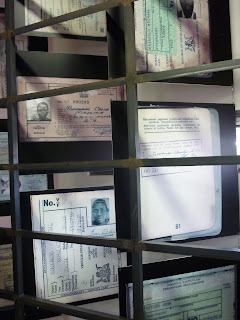I won't recount here the incredible reach, oppression and brutality of the Apartheid regime and the struggle for equality (but if you want to know more I highly recommend Nelson Mandela's autobiography, which I have almost finished). Having spent some time at both the Apartheid Museum and the Fort Prison however the main impression that has stayed with me is the sheer force of people power displayed by the resistance - a resistance which ultimately brought the ruling regime to its knees, forcing them to the negotiating table. The final exhibition at the museum celebrates the success of the end of Apartheid as a great victory for human rights, and reminds us that South Africa was the only country in Africa to free itself from colonial rule without a civil war.
Fort Prison closed in 1983 and the site has been redeveloped as a museum and the home of South Africa's new Constitutional Court. It is symbolically powerful that a place of such oppression has been reclaimed as the seat of South Africa's new democracy. South Africa's Constitution is one of the most liberal in the world; its Bill of Rights extends much further than those of most Western, developed nations. It has formed the basis of considerable litigation by individuals seeking to enforce their rights against the government - including a successful challenge to the government's policy of not allowing asylum seekers to work or study, which was struck down by the Court for infringing the right to human dignity. And the Constitution is not just a document for lawyers - it occupies an important place in the popular consciousness of South Africans. The language (if not always the practice) of human rights is part of the local vocabulary, and at least twice on this trip someone has told me in conversation that the government could not do something because 'it's unconstitutional'.
Photographs are not allowed inside the Apartheid Museum, so most of these photographs are from Constitution Hill.
 |
| The Apartheid Museum, near Soweto. When I paid for my ticket I was given a pass that directed me to enter through the 'non-white' entrance. |
 |
| Enlarged display of 'pass cards' - identity cards stating a person's race - white, black, coloured - that all South Africans were compelled to carry during apartheid |
 |
| One of the pillars outside the Apartheid Museum - a tribute to the new democracy |
 |
| A 'casspir' - these enormous, armoured vehicles were used by police and security personnel to patrol the townships. |
 |
| Another police vehicle - the water gun on top was used to break up protests and other group gatherings |
 |
| Constitution Hill - the site of the old Fort Prison and now home to the South African Constitutional Court |
 |
| Part of the Number Four section of the prison - where Nelson Mandela spent some of his 27 years in prison |
 |
| One of the solitary confinement cells at Number Four. Nelson Mandela has said, 'No one truly knows a nation until one has been inside its jails'. |
 |
| Mahatma Gandhi was one of the earlier prisoners of conscience held at Number Four. |
 |
| The view from the outdoor exercise areas of the prison. |
 |
| Solitary confinement cells in the Women's Jail within Fort Prison. Many of the women here were imprisoned simply for failing to produce an ID card. |
 |
| The foyer of South Africa's new Constitutional Court - charged with implementing and enforcing the Constitutional Bill of Rights. |
 |
| Inside the Constitutional Court - the windows around the edge of the Court allow passers by to look in, keeping the law open to the people. |

No comments:
Post a Comment